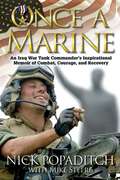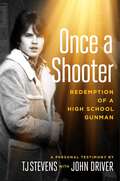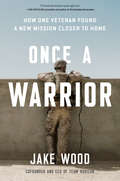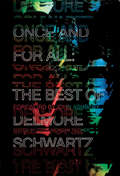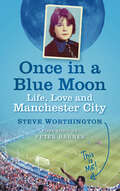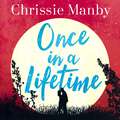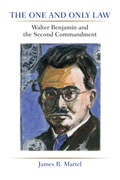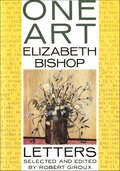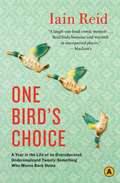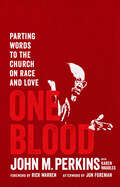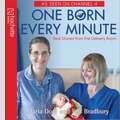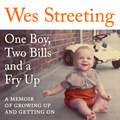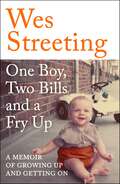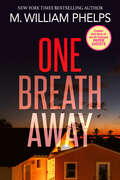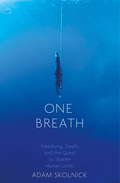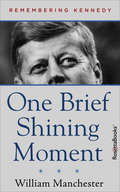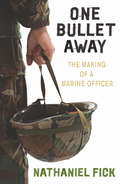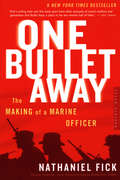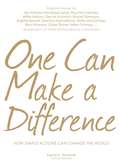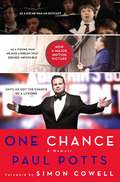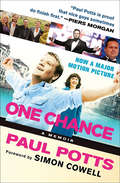- Table View
- List View
Once a Marine: An Iraq War Tank Commander’s Inspirational Memoir of Combat, Courage, and Recovery
by Nick Popaditch Mike SteereThe Silver Star–awarded marine chronicles his service in Iraq in this &“transcendent memoir of military service and its personal consequences&” (Ralph Peters, Lt. Col., ret., author of Looking For Trouble). In April, 2003, an AP photographer captured a striking image seen around the world of Gunny Sergeant Nick Popaditch smoking a victory cigar in his tank, the haunting statue of Saddam Hussein hovering in the background. Though immortalized in that moment as &“The Cigar Marine,&” Popaditch&’s fighting was far from over. The following year, he fought heroically in the battle for Fallujah and suffered grievous head wounds that left him legally blind and partially deaf. But he faced the toughest fight of his life when he returned home: the battle to remain the man and Marine he was. At first, Nick fights to get back to where he was in Iraq-in the cupola of an M1A1 main battle tank, leading Marines in combat. As the seriousness and permanence of his disabilities become more evident, Nick fights to remain in the Corps in any capacity and help his brothers in arms. Then, following a medical retirement, he battles for rightful recognition and compensation for his disabilities. Throughout his harrowing ordeal, Nick fights to maintain his honor and loyalty, waging all these battles the same way—the Marine way—because anything less would be a betrayal of all he holds dear.
Once a Shooter: Redemption of a High School Gunman
by T. J. StevensOnce, a shooter walked alone through the front doors of an unsuspecting high school in Burke, Virginia. He was young. Troubled. Tormented. Drowning in a cavernous abyss so deep that light itself seemed no longer to exist. It is an all-too-familiar story these days. After all, once a shooter enters a school or another public space, chaos always follows. Or does it? Once A Shooter chronicles the astonishing story of TJ Stevens, a suicidal high school gunman who unexpectedly experiences a miraculous transformation in the exact moment he is about to execute nine hostages and then himself. All author royalties will be donated to a charity that hosts events for troubled teens.
Once a Warrior: How One Veteran Found a New Mission Closer to Home
by Jake Wood"The book that America needs right now."--Tom Brokaw, journalist and author of The Greatest GenerationWhen Marine sniper Jake Wood arrived in the States after two bloody tours in Iraq and Afghanistan, he wasn't leaving war behind him--far from it. Ten years after returning home, Jake's unit lost more men to suicide than to enemy hands overseas. He watched in horror as his best friend and fellow Marine, Clay Hunt, plunged into depression upon returning, stripped of his purpose, community, and sense of identity. Despite Jake's attempts to intervene, Clay died by suicide, alone. Reeling, Jake remembered how only one thing had given Clay a measure of hope: joining him in Haiti on a ragtag mission to save lives immediately following the 2010 earthquake. His military training had rendered him unusually effective in high-stakes situations. What if there was a way to help stricken communities while providing a new mission to veterans? In this inspiring memoir, Jake recounts how, over the past 10 years, he and his team have recruited over 130,000 volunteers to his disaster response organization Team Rubicon. Racing against the clock, these veterans battle hurricanes, tornados, wildfires, pandemics, and civil wars, while rediscovering their life's purpose along the way.Once a Warrior provides a gut-wrenching account of the true cost of our Forever Wars--and more importantly, a glimpse of what might become of America's next greatest generation.
Once and for All: The Best of Delmore Schwartz
by Delmore Schwartz John Ashbery Craig Morgan TeicherThe publication of this book restores a missing chapter in the history of twentieth-century American literature With his New Directions debut in 1938, the twenty-five-year-old Delmore Schwartz was hailed as a genius and among the most promising writers of his generation. Yet he died in relative obscurity in 1966, wracked by mental illness and substance abuse. Sadly, his literary legacy has been overshadowed by the story of his tragic life. Among poets, Schwartz was a prototype for the confessional movement made famous by his slightly younger friends Robert Lowell and John Berryman. While his stories and novellas about Jewish American experience laid the groundwork for novels by Saul Bellow (whose Humboldt's Gift is based on Schwartz's life) and Philip Roth. Much of Schwartz's writing has been out of print for decades. This volume aims to restore Schwartz to his proper place in the canon of American literature and give new readers access to the breadth of his achievement. Included are selections from the in-print stories and poems, as well as excerpts from his long unavailable epic poem Genesis, a never-completed book-length work on T. S. Eliot, and unpublished poems from his archives.
Once in a Blue Moon: Life, Love and Manchester City
by Peter Barnes Steve WorthingtonOnce in a Blue Moon is the story of one man's never-ending affair with Manchester City. Be it playing, watching or managing, Steve 'Worthy' Worthington's life in football has never been easy. Having suffered an almost fatal road accident in the week before his ninth birthday, any aspirations for glocal stardom as a player were crushed beneath the wheels of a speeding Triumph Spitfire in 1971. As a spectator he fared no better. Over the years Manchester City and England addicts have experienced many disappointments - most of which he was there to see. As manager of his beloved Sunday League club Lee Athletic, success was a word used only on the odd occasion when he persuaded his team to turn up sober and in time for kick-off. But two things that have always kept him going were his love of the local 'Indie' music scene and an ability to find humour during the darkest of times. Join him n a vivid journey that takes you into the beating heart of 1960s and '70s working class Manchester: through give decades of football (and a bit of cricket), music and people, in the eyes and ears of an everyday bloke who turned constant failure into final triumph.
Once in a Lifetime: Reflections of a Mississippi First Lady
by Elise Varner WinterOnce in a Lifetime reveals the broad range of Elise Varner Winter's activities as first lady of Mississippi during the term of her husband, Governor William F. Winter (1980–1984). Drawn from her personal journal, which she kept daily, this account includes the frustrating moments as well as the exhilarating ones, from keeping house to visiting the White House. The position of a state's first lady is one of the most public of roles. Yet few people know what a first lady actually does. In Elise Winter's memoir, her sense of history, her talent, and her perseverance to record her activities and observations provide a unique opportunity for the reader to understand what life in the Mississippi Governor's Mansion was really like on a daily basis. This book reveals her traditional roles—planner of elegant dinners, sophisticated hostess, hands-on gardener, and steward of the Mansion and its historic collection of antique furniture and decorative arts. But she emerged as a modern first lady, intensely interested in public education and in the state penitentiary, for which she developed several important initiatives. She recounts fascinating events from Governor Winter's administration, its tensions and its accomplishments, such as passage of the Education Reform Act, a success in which Elise Winter played an indispensable role. Many of the issues of thirty years ago remain critical today—insufficient funding for education, budget deficits, prison overcrowding, and the need for prison reform. Elise Winter observes everyone and everything with a fresh eye for detail and describes them all with honesty, clarity, and simplicity. Her observations reflect her intellect and insight, as well as her sense of humor. This is a woman's story, a human story, about hopes and doubts, about setting high standards and sometimes feeling inadequate, and about the imperative of continual efforts to make her state a better place for all who live there.
Once in a Lifetime: The perfect escapist romance
by Chrissie ManbyWhat if once in a lifetime happened twice?Dani Parker had grand plans for her life - but that was twenty-two years ago. Now she's a single mother still living in the quaint seaside town of Newbay, still working at the hotel where she got her first ever job. When she bumps into ex-boyfriend Nat, Dani wonders if this might be the start of something not-quite-new. But that's before she meets his fiancée . . . Dani's daughter Flossie is sixteen - so she knows best about everything, of course. And her new boyfriend Jed is all she could ever want in a man . . . right?Flossie's grandma Jane, a widow of fifteen years, firmly believes that lightning never strikes twice. So when she finds herself visiting Bill's pet shop a little more often than necessary, she refuses to believe that the L-word has anything to do with it.In a whirlwind of cakes, elopements and more naughty puppies than they can handle, will the three women discover that 'once in a lifetime' isn't quite as rare as they thought?The wonderful and hilarious new listen from Chrissie Manby, perfect for fans of Sophie Kinsella, Jill Mansell and Trisha Ashley.Praise for Chrissie Manby: 'This sassy and addictive read will make you laugh - a lot!' - Closer'I've been a fan of Manby's writing for years and thoroughly enjoyed this' - Daily Mail'Perfect, unputdownable summer adventures.' - Jenny Colgan'Manby's novels are made for holidays.' - Glamour'Nothing short of brilliant' - Marie Claire'A gloriously delicious read! . . . Packed with warm characters and hilarious situations' - www.handwrittengirl.com'[This novel] was funny and emotional, it was heartwarming, it was so genuine and realistic and it is a MUST READ this autumn. Highly recommended!' - On My Bookshelf(P)2018 Hodder & Stoughton Limited
One And Only Law: Walter Benjamin And The Second Commandment
by James MartelWalter Benjamin's "Critique of Violence," widely considered his final word on law, proposes that all manifestations of law are false stand-ins for divine principles of truth and justice that are no longer available to human beings. However, he also suggests that we must have law--we are held under a divine sanction that does not allow us to escape our responsibilities. James R. Martel argues that this paradox is resolved by considering that, for Benjamin, there is only one law that we must obey absolutely--the Second Commandment against idolatry. What remains of law when its false bases of authority are undermined would be a form of legal and political anarchism, quite unlike the current system of law based on consistency and precedent. Martel engages with the ideas of key authors including Alain Badiou, Immanuel Kant, and H. L. A. Hart in order to revisit common contemporary assumptions about law. He reveals how, when treated in constellation with these authors, Benjamin offers a way for human beings to become responsible for their own law, thereby avoiding the false appearance of a secular legal practice that remains bound by occult theologies and fetishisms.
One Art: Letters
by Elizabeth BishopRobert Lowell once remarked, "When Elizabeth Bishop's letters are published (as they will be), she will be recognized as not only one of the best, but one of the most prolific writers of our century." One Art is the magificent confirmation of Lowell's prediction.From several thousand letters, written by Bishop over fifty years—from 1928, when she was seventeen, to the day of her death, in Boston in 1979—Robert Giroux, the poet's longtime friend and editor, has selected over five hundred missives for this volume. In a way, the letters comprise Bishop's autobiography, and Giroux has greatly enhanced them with his own detailed, candid, and highly informative introduction. One Art takes us behind Bishop's formal sophistication and reserve, fully displaying the gift for friendship, the striving for perfection, and the passionate, questing, rigorous spirit that made her a great artist.
One Bird's Choice: A Year in the Life of an Overeducated, Underemployed Twenty-Something Who Moves Back Home
by Iain ReidMeet Iain Reid: an overeducated, underemployed twenty-something who moves back in with his lovable but eccentric parents on their hobby farm. But what starts out as a temporary arrangement turns into a year-long extended stay, in which Iain finds himself fighting with the farm fowl, taking fashion advice from the elderly, fattening up on home-cooked food, and ultimately easing (perhaps a little too comfortably) into the semi-retired lifestyle. Hilarious and heartwarming, One Bird’s Choice is an endearingly funny comic memoir that bridges the divide between the Boomer and Boomerang generations.
One Blood: Parting Words to the Church on Race and Love
by John PerkinsDr. Perkins&’ final manifesto on race, faith, and reconciliation We are living in historic times. Not since the civil rights movement of the 60s has our country been this vigorously engaged in the reconciliation conversation. There is a great opportunity right now for culture to change, to be a more perfect union. However, it cannot be done without the church, because the faith of the people is more powerful than any law government can enact. The church is the heart and moral compass of a nation. To turn a country away from God, you must sideline the church. To turn a nation to God, the church must turn first. Racism won't end in America until the church is reconciled first. Then—and only then—can it spiritually and morally lead the way.Dr. John M. Perkins is a leading civil rights activist today. He grew up in a Mississippi sharecropping family, was an early pioneer of the civil rights movement, and has dedicated his life to the cause of racial equality. In this, his crowning work, Dr. Perkins speaks honestly to the church about reconciliation, discipleship, and justice... and what it really takes to live out biblical reconciliation. He offers a call to repentance to both the white church and the black church. He explains how band-aid approaches of the past won't do. And while applauding these starter efforts, he holds that true reconciliation won't happen until we get more intentional and relational. True friendships must happen, and on every level. This will take the whole church, not just the pastors and staff. The racial reconciliation of our churches and nation won't be done with big campaigns or through mass media. It will come one loving, sacrificial relationship at a time. The gospel and all that it encompasses has always traveled best relationally. We have much to learn from each other and each have unique poverties that can only be filled by one another. The way forward is to become "wounded healers" who bandage each other up as we discover what the family of God really looks like. Real relationships, sacrificial love between actual people, is the way forward. Nothing less will do.
One Blood: Parting Words to the Church on Race and Love
by John PerkinsDr. Perkins&’ final manifesto on race, faith, and reconciliation We are living in historic times. Not since the civil rights movement of the 60s has our country been this vigorously engaged in the reconciliation conversation. There is a great opportunity right now for culture to change, to be a more perfect union. However, it cannot be done without the church, because the faith of the people is more powerful than any law government can enact. The church is the heart and moral compass of a nation. To turn a country away from God, you must sideline the church. To turn a nation to God, the church must turn first. Racism won't end in America until the church is reconciled first. Then—and only then—can it spiritually and morally lead the way.Dr. John M. Perkins is a leading civil rights activist today. He grew up in a Mississippi sharecropping family, was an early pioneer of the civil rights movement, and has dedicated his life to the cause of racial equality. In this, his crowning work, Dr. Perkins speaks honestly to the church about reconciliation, discipleship, and justice... and what it really takes to live out biblical reconciliation. He offers a call to repentance to both the white church and the black church. He explains how band-aid approaches of the past won't do. And while applauding these starter efforts, he holds that true reconciliation won't happen until we get more intentional and relational. True friendships must happen, and on every level. This will take the whole church, not just the pastors and staff. The racial reconciliation of our churches and nation won't be done with big campaigns or through mass media. It will come one loving, sacrificial relationship at a time. The gospel and all that it encompasses has always traveled best relationally. We have much to learn from each other and each have unique poverties that can only be filled by one another. The way forward is to become "wounded healers" who bandage each other up as we discover what the family of God really looks like. Real relationships, sacrificial love between actual people, is the way forward. Nothing less will do.
One Born Every Minute: Real Stories from the Delivery Room
by Maria Dore Ros BradburyONE BORN EVERY MINUTE, Channel 4's Bafta-winning documentary series, was the critical and popular smash-hit of 2010. And in February 2011, we'll be back on the maternity ward for twelve brand-new, thrilling episodes.In this wonderful new book, midwives Maria Dore and Ros Bradbury look back over their careers and reveal the extraordinary experiences that fill every their working day - from first-time mums with unusual birth plans to overwhelmed dads who end up on the delivery room floor. And, of course, the beautiful babies who make it all worthwhile. Maria explains, 'To be part of anyone's birth experience is just the best. You never quite get over that miracle.'
One Boy, Two Bills and a Fry Up: A Memoir of Growing Up and Getting On
by Wes StreetingAn inspiring, witty East End growing up memoir by leading Labour MP Wes Streeting, vividly portraying the power of family and education to help him escape poverty and transform his life.Wes Streeting might have ended up in prison rather than in parliament. His maternal grandfather Bill, an unsuccessful armed robber, spent time behind bars, as did his grandmother, who was also a political campaigner.Brought up on a Stepney council estate, the young Streeting saw his teenage parents struggle to provide for him. In One Boy, Two Bills & A Fry Up he brings to life the poverty, humiliation and incredible struggle for them choosing whether to feed the meter and heat the flat, put carpet on the floor, or food on the table.Wes Streeting knows it was the help and inspiration he received from the great characters that surrounded him, especially his paternal grandfather (also called Bill), that ultimately set him on the way to Cambridge and then Parliament. He knew he could draw on the strengths in childhood to eventually come out, and to go on and face his now successful struggle with kidney cancer.This honest, uplifting, affectionate memoir is a tribute to the love and support which set him on his way out of poverty, and informs everything about Wes Streeting's mission now in politics.(P) 2023 Hodder & Stoughton Limited
One Boy, Two Bills and a Fry Up: A Memoir of Growing Up and Getting On
by Wes Streeting'[A] compelling story of overcoming adversity... Unexpectedly fascinating... amazingly inspiriting...' --- The Observer'Extraordinary' --- Evening Standard 'Funny, honest and at times heart-breaking - a terrific read.' --- Lorraine Kelly'For a politician to have such an extraordinary story to tell is rare. For that politician to be able to tell it with such eloquence and benevolence is rarer still. This book is a triumph.' --- Alan Johnson'This riveting tale of social aspiration leads us from the East End to Westminster in detailed honesty.' --- Ian McKellen 'A moving and inspiring hymn to the ups and downs of life - to love, to adversity and above all courage.' ---Michael Cashman 'Compulsive reading: Wes's story is inspiring, surprising and full of compassion.' --- Jess PhillipsWes Streeting might have ended up in prison rather than in parliament. His maternal grandfather Bill, an unsuccessful armed robber, spent time behind bars, as did his grandmother, who was also a political campaigner.Brought up on a Stepney council estate, the young Streeting saw his teenage parents struggle to provide for him. In One Boy, Two Bills & A Fry Up he brings to life the poverty, humiliation and incredible struggle for them choosing whether to feed the meter and heat the flat, put carpet on the floor, or food on the table.Wes Streeting knows it was the help and inspiration he received from the great characters that surrounded him, especially his paternal grandfather (also called Bill), that ultimately set him on the way to Cambridge and then Parliament. He knew he could draw on the strengths in childhood to eventually come out, and to go on and face his now successful struggle with kidney cancer.This honest, uplifting, affectionate memoir is a tribute to the love and support which set him on his way out of poverty, and informs everything about Wes Streeting's mission now in politics.
One Boy, Two Bills and a Fry Up: A Memoir of Growing Up and Getting On
by Wes Streeting'[A] compelling story of overcoming adversity... Unexpectedly fascinating... amazingly inspiriting...' --- The Observer'Funny, honest and at times heart-breaking - a terrific read.' --- Lorraine Kelly'For a politician to have such an extraordinary story to tell is rare. For that politician to be able to tell it with such eloquence and benevolence is rarer still. This book is a triumph.' --- Alan Johnson'This riveting tale of social aspiration leads us from the East End to Westminster in detailed honesty.' --- Ian McKellen 'A moving and inspiring hymn to the ups and downs of life - to love, to adversity and above all courage.' ---Michael Cashman 'Compulsive reading: Wes's story is inspiring, surprising and full of compassion.' --- Jess PhillipsWes Streeting might have ended up in prison rather than in parliament. His maternal grandfather Bill, an unsuccessful armed robber, spent time behind bars, as did his grandmother, who was also a political campaigner.Brought up on a Stepney council estate, the young Streeting saw his teenage parents struggle to provide for him. In One Boy, Two Bills & A Fry Up he brings to life the poverty, humiliation and incredible struggle for them choosing whether to feed the meter and heat the flat, put carpet on the floor, or food on the table.Wes Streeting knows it was the help and inspiration he received from the great characters that surrounded him, especially his paternal grandfather (also called Bill), that ultimately set him on the way to Cambridge and then Parliament. He knew he could draw on the strengths in childhood to eventually come out, and to go on and face his now successful struggle with kidney cancer.This honest, uplifting, affectionate memoir is a tribute to the love and support which set him on his way out of poverty, and informs everything about Wes Streeting's mission now in politics.
One Breath Away: The Hiccup Girl - From Media Darling to Convicted Killer
by M. William PhelpsThe true-crime story of a Florida woman's violent downfall from viral fame, by the New York Times bestselling author of She Survived: Jane.When she was fifteenn, Jennifer Mee developed an unrelenting case of the hiccups—hiccupping as many as fifty times a minute for months. Soon the Florida teen's strange story went viral. Dubbed the “Hiccup Girl” by the media, she gained international sympathy and appeared on a slew of popular TV shows. Eventually, Jennifer's hiccups went away—and so did her fame.Depressed and craving affection, Jennifer hooked up with the wrong people and slipped into drug dealing and street life—a downward spiral that led to the murder of an innocent young man. Now, renowned investigative journalist M. William Phelps expertly recounts Jennifer's shocking true story of thwarted desires, betrayed trust, and deadly manipulation.Praise for M. William Phelps“One of America's finest true-crime writers.” —Vincent Bugliosi, New York Times bestselling author of Helter Skelter“Phelps is the Harlan Coben of real-life thrillers.” —Allison Brennan, New York Times bestselling author of Tell No LiesIncludes sixteen pages of dramatic photos
One Breath: Freediving, Death, and the Quest to Shatter Human Limits
by Adam SkolnickOne Breath is a gripping and powerful exploration of the strange and fascinating sport of freediving, and of the tragic, untimely death of America's greatest freediver Competitive freediving-a sport built on diving as deep as possible on a single breath-tests the limits of human ability in the most hostile environment on earth. The unique and eclectic breed of individuals who freedive at the highest level regularly dive hundreds of feet below the ocean's surface, reaching such depths that their organs compress, light disappears, and one mistake could kill them.Even among freedivers, few have ever gone as deep as Nicholas Mevoli. A handsome young American with an unmatched talent for the sport, Nick was among freediving's brightest stars. He was also an extraordinary individual, one who rebelled against the vapid and commoditized society around him by relentlessly questing for something more meaningful and authentic, whatever the risks. So when Nick Mevoli arrived at Vertical Blue in 2013, the world's premier freediving competition, he was widely expected to challenge records and continue his meteoric rise to stardom. Instead, before the end of that fateful competition Nick Mevoli had died, a victim of the sport that had made him a star, and the very future of free diving was called into question. With unparalleled access and masterfully crafted prose, One Breath tells his unforgettable story, and of the sport which shaped and ultimately destroyed him.
One Brief Shining Moment: Remembering Kennedy
by William ManchesterA New York Times–bestselling historian looks back on the Camelot of the early 1960s, and &“make[s] the Kennedy days look glamorous again&” (Kirkus Reviews, starred review). In his renowned biographies Portrait of a President and The Death of a President, William Manchester intimately and meticulously detailed the life and death of President John F. Kennedy. One Brief Shining Moment is a celebration of that life, based on Manchester&’s own recollections of his time with one of America&’s most famous families. John Kennedy first met William Manchester in 1946, beginning a friendship that would follow him to Washington and eventually the White House. But, beyond the closed doors of the Oval Office, Manchester enjoyed a close relationship with the Kennedys. Drawing on family gatherings in New England, trips along the campaign trail, and informal private talks with JFK himself, this is William Manchester&’s personal account of the man behind the legend, someone he truly admired and was proud to call a friend. One Brief Shining Moment provides a firsthand look at the thought process behind JFK&’s most important decisions as president, his drive to move the country in a new direction, and his closest relationships. This is a book about a man, about a life, and about a triumphant moment in American history.
One Bullet Away: The Making Of A US Marine Officer
by Nathaniel FickThe most eloquent and personal story of a young man at war since Geoffrey Wellum's FIRST LIGHTUntil a winter evening in 1998 Nathaniel was just another history student on a comfortable career trajectory of high school to college to white collar job. Then he went to a lecture by a Wall Street Journal reporter who had just published a book on the US Marines. It brought forth a latent desire to break free of the 'seat belt and safety goggle, safety-first' culture: to be a warrior. He passed the gruelling selection course and joined the Marine Corps on graduation. Posted to a Marine Regiment in the wake of 9/11, he took part in the invasion of Afghanistan, then led a platoon of their elite Recon Battalion during the invasion of Iraq.This is not a book about the Iraq invasion as such: it is an articulate and deeply thoughtful young man's account of what it means to fight in the frontline, to risk not just death or injury, but psychological harm. He reveals some of the awful dilemmas war can bring, horrible problems to which there is no 'right' answer, but a decision had to be made quickly -- by him alone. In combat you are just one bullet away from death -- or promotion. But this doesn't focus the mind: it makes it freeze up -- unless your training is so thorough that you overcome exhaustion and terror. 'Nate' took 65 men to war and came home with all 65. He proved himself an excellent officer and won promotion, but resigned in 2003 to write this book and attend Harvard Business School.
One Bullet Away: The Making of a Marine Officer
by Nathaniel FickThe New York Times bestseller that &“provides a close-up and often harrowing look at Fick&’s service both in Iraq and Afghanistan&” (U.S. News & World Report). If the Marines are &“the few, the proud,&” Recon Marines are the fewest and the proudest. Nathaniel Fick&’s career begins with a hellish summer at Quantico, after his junior year at Dartmouth. He leads a platoon in Afghanistan just after 9/11 and advances to the pinnacle—Recon— two years later, on the eve of war with Iraq. His vast skill set puts him in front of the front lines, leading twenty-two Marines into the deadliest conflict since Vietnam. He vows to bring all his men home safely, and to do so he&’ll need more than his top-flight education. Fick unveils the process that makes Marine officers such legendary leaders and shares his hard-won insights into the differences between military ideals and military practice, which can mock those ideals. In this deeply thoughtful account of what it&’s like to fight on today&’s front lines, Fick reveals the crushing pressure on young leaders in combat. Split-second decisions might have national consequences or horrible immediate repercussions, but hesitation isn&’t an option. One Bullet Away never shrinks from blunt truths, but ultimately it is an inspiring account of mastering the art of war. &“Fick&’s writing style sets this book apart from other accounts of recent conflicts and guarantees One Bullet Away a place in the war memorial hall of fame.&”—USA Today &“What One Bullet Away accomplishes, in a way all the blather on cable TV never will, is to give readers real insights into the modern war and its warriors.&”—Rocky Mountain News
One Bullet Away: The making of a US Marine Officer
by Nathaniel FickThe most eloquent and personal story of a young man at war since Geoffrey Wellum's FIRST LIGHTUntil a winter evening in 1998 Nathaniel was just another history student on a comfortable career trajectory of high school to college to white collar job. Then he went to a lecture by a Wall Street Journal reporter who had just published a book on the US Marines. It brought forth a latent desire to break free of the 'seat belt and safety goggle, safety-first' culture: to be a warrior. He passed the gruelling selection course and joined the Marine Corps on graduation. Posted to a Marine Regiment in the wake of 9/11, he took part in the invasion of Afghanistan, then led a platoon of their elite Recon Battalion during the invasion of Iraq.This is not a book about the Iraq invasion as such: it is an articulate and deeply thoughtful young man's account of what it means to fight in the frontline, to risk not just death or injury, but psychological harm. He reveals some of the awful dilemmas war can bring, horrible problems to which there is no 'right' answer, but a decision had to be made quickly -- by him alone. In combat you are just one bullet away from death -- or promotion. But this doesn't focus the mind: it makes it freeze up -- unless your training is so thorough that you overcome exhaustion and terror. 'Nate' took 65 men to war and came home with all 65. He proved himself an excellent officer and won promotion, but resigned in 2003 to write this book and attend Harvard Business School.
One Can Make a Difference
by Ingrid E. Newkirk Jane RatcliffeWhen Ingrid Newkirk almost single-handedly set into motion the largest animal-rights organization in the world, she knew that one person can make a difference. In this book, Ingrid has collected the wisdom, stories, and insight of dozens of activists and world-changers who have proven that one person can make a movement. This engaging and enlightening collection is a call to action for readers everywhere. Because one can make a difference.
One Chance
by Paul Potts Foreword by Simon CowellA memoir by international opera star Paul Potts, winner of the first season of OC BritainOCOs Got TalentOCO"
One Chance: A Memoir
by Paul Potts Foreword by Simon CowellA memoir by international opera star Paul Potts, winner of the first season of OC BritainOCOs Got TalentOCO"
